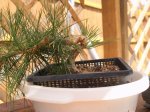bonhe
Masterpiece
I create this post to show you my collection of Korean black pine (KBP). I hope it could make everyone especially young people will love to make their bonsai from the seedling. It trained me well in patience and love with the plants; besides it helped me not only practice wiring technique, but understand physiology and pathology as well.
Those seedlings are 8 years old. My friend gave me the seedlings 7 years ago. They have been in colanders at first, then most of them were put into the 2nd colander. Few of them were transferred to clay orchid and plastic pots. At this time I still have 29 trees after I gave away some and lost some!
They were wired quite well when they were 2-3 years old! Hehe, it looks as same as the parents try to teach their children when they are still young, doesn't it? Then I removed the wires. From that time, the training has been mostly "pick and choose" to change direction of the trunk line!

The sacrificed branch will be removed in this winter.

The upper trunk line.

Where the "pick and choose" is.


Bonhe
Those seedlings are 8 years old. My friend gave me the seedlings 7 years ago. They have been in colanders at first, then most of them were put into the 2nd colander. Few of them were transferred to clay orchid and plastic pots. At this time I still have 29 trees after I gave away some and lost some!
They were wired quite well when they were 2-3 years old! Hehe, it looks as same as the parents try to teach their children when they are still young, doesn't it? Then I removed the wires. From that time, the training has been mostly "pick and choose" to change direction of the trunk line!

The sacrificed branch will be removed in this winter.

The upper trunk line.

Where the "pick and choose" is.


Bonhe




















